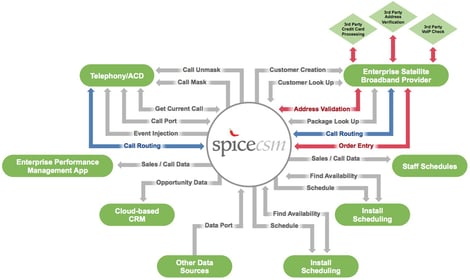 A company’s call center is vital to its customer support operations, so it’s critical to give agents the tools they need to provide premium, responsive service. As such, businesses invest in solutions like helpdesk software, call center scripting and customer experience management to enhance the encounter. However, technology has created certain problems even as it’s solving others. Disparate platforms make the agent’s job more difficult as they must access and navigate multiple tools to resolve customer issues.
A company’s call center is vital to its customer support operations, so it’s critical to give agents the tools they need to provide premium, responsive service. As such, businesses invest in solutions like helpdesk software, call center scripting and customer experience management to enhance the encounter. However, technology has created certain problems even as it’s solving others. Disparate platforms make the agent’s job more difficult as they must access and navigate multiple tools to resolve customer issues.
Developers have responded to this challenge with a unified desktop solution that’s capable of bringing several applications under one, streamlined platform. It solves many of the common problems experienced by agents in the call center, offering the following benefits:
- Eliminate multiple search field disparities: Agents attempting to access customer data and knowledge bases must utilize several tools to obtain the necessary information, which involves redundant searching. A unified desktop unites disparate systems, enabling single-search capabilities. Call center agents have the data they need in front of them to respond to customers quickly.
- No more Alt tab shortcut navigation: In a typical call center, an agent may be navigating among up to 15 unique systems – all to resolve one customer issue. The cumbersome, time consuming Alt tab shortcut key is commonly used. When all disparate solutions are connected in a single desktop, agents no longer need to rely on this counterproductive shortcut.
- Training resources for new agents are considerably reduced: Not only must new hires train on the individual platforms, but they must also learn how to quickly navigate among multiple applications. With a unified desktop, agents must only master one solution that carries with it all the features of the individual components.
- Do away with multi-brand, multi-function inefficiencies: The array of call center applications from different developers each have separate, unique functions; agents must learn them all, which can be covered by extensive training. However, many still must use cheat sheets and notebooks to guide them through customer encounters, taking them away from the application they’re working in and distracting them from customer care. The Unified Desktop increases agent empowerment by offering a prompt and accurate response to the customer who becomes very satisfied and engaged.
- Cut back on cutting and pasting: Transitioning customer data between and among disparate systems requires agents to use the copy/cut and paste methodology meant for word processing – not call center tasks. Within a unified desktop, essential information is maintained in one place, thus eliminating the need to transfer details over with these shortcut features.
- Always have access to updated, accurate data: If information changes in one application, agents must spend time moving the updates over into all other applications where they may be needed for future customer encounters. The unified desktop approach ensures data is updated throughout all solutions.
Implementing a unified desktop consolidates various customer engagement tools, simplifies the user interface and streamlines call center activities. In addition, a unified solution builds on a company’s existing landscape rather than forcing it to purchase an entirely new suite. The advantages of uniting multiple unique applications will lead many businesses to invest in this technology in the coming months.
Interested to simplify, automate and deliver your applications in one unified desktop?



